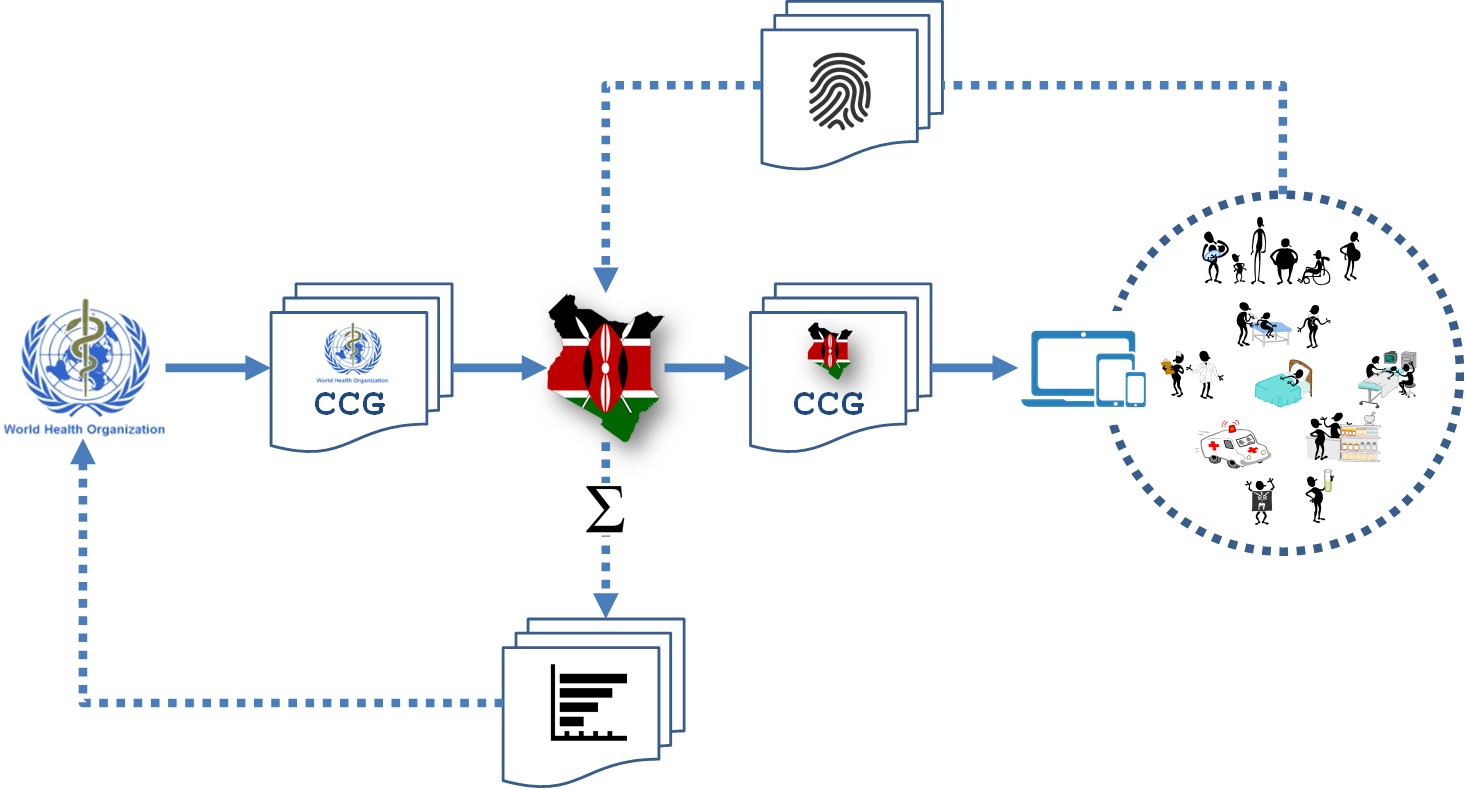Computable Care Guidelines
The Computable Care Guidelines (CCG) profile supports the expression of and sharing of health care guidelines in a grammar that can be ingested and understood by a software application.
Summary
The evidence shows that improved adherence to care guidelines can yield significant population health impacts. The Computable Care Guidelines (CCG) profile helps close what WHO calls the know-do gap; the sometimes wide chasm between what we know are the evidence-based best practices and what is actually done during health care encounters. To close this gap, CCG provides a standards-based way to describe and to share:
- the minimum data set (including coded content) that should be collected during an encounter;
- the "workflow logic" that is to be triggered based on collected content; and
- the reportable health system management indicators that may be automatically generated from the person-centric healthcare transactions.
Importantly, CCG gives us a way to track and monitor the care delivery activities (what happened) and it provides us with a way to increase guideline-adherence by indicating what should happen. In this way, it supports both feedback and feed-forward process control.
It is expected that guideline-development organizations (e.g. WHO, CDC, Diabetes Canada) would create and publish CCGs. These CCGs may be contextualized by implementing jurisdictions (e.g. Kenya Ministry of Health) to create localized versions. The jurisdictional CCGs would be ingested by computer, tablet and phone-based digital health solutions to operationalize guideline-based care across the health system. These digital health solutions would report CCG-defined management metrics back to the jurisdiction.
Benefits
“Health care in all global settings today suffers from high levels of defects in quality across many domains, and this poor-quality care causes ongoing damage to human health. Hospitalizations in low- and middle-income countries (LMICs) lead to 134 million adverse events each year, and these adverse events contribute to more than 2.5 million deaths annually. More than 830 million people with a diagnosed noncommunicable disease (NCD) are not being treated, and more than 4 million avoidable quality-related deaths each year are attributable to ineffective care for NCDs. In total, between 5.7 and 8.4 million deaths occur annually from poor quality of care in LMICs for the selected set of conditions the committee analyzed… which represents between 10 and 15 percent of the total deaths in LMICs reported by the World Health Organization (WHO) in 2015. For some conditions, deaths due to poor quality contribute to more than half of overall deaths." (Crossing the Global Quality Chasm (2018))
Details
The CCG profile leverages IHE's Dynamic Care Planning (DCP) profile. Similar to DCP, CCG expresses the care guideline using the CarePlan, PlanDefinition, ActivityDefinition and Task resources defined in the HL7 FHIR standard. CCG particularly focuses on the definition of the minimum data sets needed to operationalize the evidence-based care and on the use of IHE's mobile Aggregate Data Exchange (mADX) profile to define reportable indicators that may be generated from these data sets. The mADX profile leverages the Measure and MeasureReport FHIR resources.
Systems Affected
- Guideline-development bodies will generate CCGs and publish them as FHIR bundles hosted on a FHIR server
- Jurisdictions will contextual CCGs and publish them as FHIR bundles hosted on a FHIR server
- Digital health solution developers will modify their applications to enable them to ingest CCGs, to operationalize a UI based on the minimum data sets and the care workflow logic, and to generate and report the management metrics (mADX messages) as defined by the CCG
Actors & Transactions:
TBD
Specification
Profile Status: Final Text <Replace "Final Text" with "Trial Implementation" or "Public Comment" as appropriate.>
Documents:
<Provide direct links to the specific volumes or supplements, and list the volume sections relevant to this profile. This is a simple inventory of official normative and informative text. If you would like to provide a reading guide or walkthrough of what is in each of the different sections for implementers or users, do that in the Profile FAQ or the Profile Implementation Page linked below. If the profile uses transactions from multiple Tech. Frameworks, repeat the structure below.>
IHE Radiology Technical Framework:
Underlying Standards:
<list all the standards on which the profile is based; if possible with links to sources>
See Also
<The following sections can be left out if there is nothing to point to. This is just to show where such information can go.>
Related Profiles
<List profiles this one depends on, profiles that depend on this one, profiles that are synergistic with this one. Start with the name of the other profile as a link and then explain the relationship.>
- Reporting Workflow [RWF] may use Evidence Documents as inputs to the reporting process.
- Simple Image & Numeric Reports [SINR] may include data copied from Evidence Documents.
- Cross-enterprise Document Sharing for Imaging [XDS-I] can be used to share Evidence Documents between sites over a network.
- Portable Data for Imaging [PDI] can store Evidence Documents on media such as CDs.
- Import Reconciliation Workflow [IRWF] can fix patient ids, etc. of Evidence Documents when importing.
Consumer Information
The Profile FAQ Template answers typical questions about what the Profile does. <Replace the link with a link to the actual FAQ page for the Profile>
The Profile Purchasing Template describes considerations when purchasing equipment to deploy this Profile. <Replace the link with a link to the actual Purchasing page for the Profile>
Implementer Information
The Profile Implementation Template provides additional information about implementing this Profile in software. <Replace the link with a link to the actual Implementation page for the Profile>
Reference Articles
<List References (good and bad) (with link if possible) to Journal Articles that mention IHE's work (and hopefully include some analysis). Go ahead, Google: IHE <Profile Name> abstract or Google: IHE <Profile Name> and under the "more" select "Scholar". You might be surprised. >
This page is based on the Profile Overview Template <Delete this Category Templates line since your Profile page is no longer a template.>
